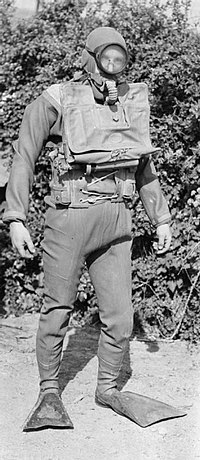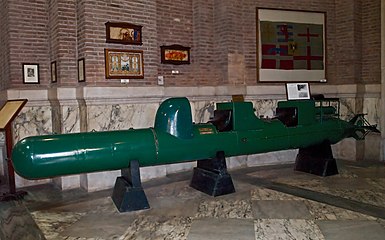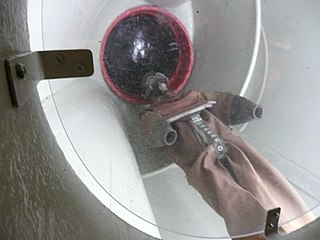
Quick Facts

Biography
A frogman is someone who is trained in scuba diving or swimming underwater in a tactical capacity that includes combat. Such personnel are also known by the more formal names of combat diver, combatant diver, or combat swimmer. The word frogman arose from Italian "uomo rana" around 1940 from the appearance of a diver in a shiny drysuit and large fins.
Combat swimming is often used to mean combat diving. Such actions are a historical form of "frogman" activity and an important feature of naval special operations.
The term frogman is occasionally used to refer to a civilian scuba diver. Some sport diving clubs include the word Frogmen in their names. The preferred term by scuba users is diver, but the frogman epithet persists in informal usage by non-divers, especially in the media and often referring to professional scuba divers, such as in a police diving role.
In the U.S. military and intelligence community, divers trained in scuba or CCUBA who deploy for tactical assault missions are called "combat divers". This term is used to refer to the Navy SEALs, operatives of the CIA's Special Activities Division, elements of Marine Recon, Army Ranger Regimental Reconnaissance Company members, Army Special Forces divers, Air Force Pararescue, Air Force Combat Controllers, U.S. Coast Guard Helicopter Rescue Swimmers, United States Naval Search and Rescue Swimmers, United States Air Force Special Operations Weather Technicians, and the Navy Explosive Ordnance Disposal (EOD) units. In Britain, police divers have often been called "police frogmen".
Some countries' tactical diver organizations include a translation of the word frogman in their official names, e.g., Denmark's Frømandskorpset and Norway's Froskemanskorpset; others call themselves "combat divers" or similar. Others call themselves by indefinite names such as "special group 13" and "special operations unit".
Many nations and some irregular armed groups deploy or have deployed combat frogmen.
Scope of operations

Tactical diving is a branch of professional diving carried out by armed forces and tactical units. They may be divided into:
- Combat/assault divers.
- Special mission work divers (called Clearance Divers in the British Royal Navy and Royal Australian Navy), who do general work underwater.
- Work divers who are trained in defusing mines and removing other explosives underwater.
These groups may overlap, and the same men may serve as assault divers and work divers, such as the Australian Clearance Diving Branch (RAN).
The range of operations performed by these operatives includes:
- Amphibious assault: stealthy deployment of land or boarding forces. The vast majority of combat swimmer missions are simply to get "from here to there" and arrive suitably equipped and in sufficient physical condition to fight on arrival. The deployment of tactical forces using the arrival by water to assault land targets, oil platforms, or surface ship targets (as in boardings for seizure of evidence) is a major driver behind the equipping and training of combat swimmers. The purposes are many, but include feint and deception, counter-drug, law enforcement, counter-terrorism, and counter-proliferation missions.
- Sabotage: This includes putting limpet mines on ships.
- Clandestine surveying: Surveying a beach before a troop landing, or other forms of unauthorized underwater surveying in denied waters.
- Clandestine underwater work, e.g.:
- Recovering underwater objects.
- Clandestine fitting of monitoring devices on submarine communications cables in enemy waters.
- Investigating unidentified divers, or a sonar echo that may be unidentified divers. Diving sea-police work may be included here. See anti-frogman techniques.
- Checking ships, boats, structures, and harbors for limpet mines and other sabotage; and ordinary routine maintenance in war conditions. If the inspection divers during this find attacking frogmen laying mines, this category may merge into the previous category.
- Underwater mine clearance and bomb disposal.
Typically, a frogman with closed circuit oxygen rebreathing equipment will stay within a depth limit of 20 feet (6.1 m) with limited deeper excursions to a maximum of 50 feet (15 m) because of the risk of seizure due to acute oxygen toxicity. The use of nitrox or mixed gas rebreathers can extend this depth range considerably, but this may be beyond the scope of operations, depending on the unit.
Mission descriptions
The U.S. and U.K. forces use these official definitions for mission descriptors:
- Stealthy
- Keeping out of sight (e.g., underwater) when approaching the target.
- Covert
- Carrying out an action of which the enemy may become aware, but whose perpetrator cannot easily be discovered or apprehended. Covert action often involves military force which cannot be hidden once it has happened. Stealth on approach, and frequently on departure, may be used.
- Clandestine
- It is intended that the enemy does not find out then or afterwards that the action has happened. Installing eavesdropping devices is the best example. Approach, installing the devices, and departure are all to be kept from the knowledge of the enemy. If the operation or its purpose is exposed, then the actor will usually make sure that the action at least remains "covert", or unattributable: e.g., "... the secretary will disavow any knowledge of your actions".
Defending against frogmen
Anti-frogman techniques are security methods developed to protect watercraft, ports and installations, and other sensitive resources both in or nearby vulnerable waterways from potential threats or intrusions by frogmen.
History

In ancient Roman and Greek times, etc., there were instances of men swimming or diving for combat, sometimes using a hollow plant stem or a long bone as a snorkel. Diving with snorkel is mentioned by Aristotle (4th century BC). The earliest descriptions of frogmen in war are found in Thukydides' History of the Peloponnesian War. The first instance was in 425 BC, when the Athenian fleet besieged the Spartans on the small island of Sphacteria. The Spartans managed to get supplies from the mainland by underwater swimmers towing submerged sacks with supplies. In another incident of the same war, in 415 BC, the Athenians used combat divers in the port of Syracuse, Sicily. The Syracuseans had planted vertical wooden poles in the bottom around their port, to prevent the Athenian triremes from entering. The poles were submerged, not visible above the sea level. The Athenians used various means to cut these obstacles, including divers with saws. It is believed that the underwater sawing required snorkels for breathing and diving weights to keep the divers stable.
The Hungarian Chronicon Pictum claims that Henry III's 1052 invasion of Hungary was defeated by a skillful diver who sabotaged Henry's supply fleet. The unexpected sinking of the ships is confirmed by German chronicles.
Italy started World War II with a commando frogman force already trained. Britain, Germany, the United States, and the Soviet Union started commando frogman forces during World War II.
First frogmen
The word frogman appeared first in the stage name The Fearless Frogman of Paul Boyton, who since the 1870s broke records in long distance swimming to demonstrate a new invented rubber immersion suit, which inflated hood had a frog-like shape. As a stunt show hero in that suit he played a military diver (attaching mines to ships etc.) long before such divers existed.
The first modern frogmen were the World War II Italian commando frogmen, of Decima Flottiglia MAS (now "ComSubIn": Comando Raggruppamento Subacquei e Incursori Teseo Tesei) which formed in 1938 and was first in action in 1940. Originally these divers were called "Uomini Gamma" because they were members of the top secret special unit called "Gruppo Gamma", which originated from the kind of Pirelli rubber skin-suit nicknamed muta gamma used by these divers. Later they were nicknamed "Uomini Rana", Italian for "frog men", because of an underwater swimming frog kick style, similar to that of frogs, or because their fins looked like frog's feet.
This special corps used an early oxygen rebreather scuba set, the Auto Respiratore ad Ossigeno (A.R.O), a development of the Dräger oxygen self-contained breathing apparatus designed for the mining industry and of the Davis Submerged Escape Apparatus made by Siebe, Gorman & Co and by Bergomi, designed for escaping from sunken submarines. This was used from about 1920 for spearfishing by Italian sport divers, modified and adapted by the Italian navy engineers for safe underwater use and built by Pirelli and SALVAS from about 1933, and so became a precursor of the modern diving rebreather.
For this new way of underwater diving, the Italian frogmen trained in La Spezia, Liguria, using the newly available Genoese free diving spearfishing equipment; diving mask, snorkel, swimfins, and rubber dry suit, the first specially made diving watch (the luminescent Panerai), and the new A.R.O. scuba unit. This was a revolutionary alternative way to dive, and the start of the transition from the usual heavy underwater diving equipment of the hard hat divers which had been in general use since the 18th century, to self-contained divers, free of being tethered by an air line and rope connection.
Wartime operations
After Italy declared war, the Decima Flottiglia MAS (Xª MAS) attempted several attacks on British naval bases in the Mediterranean between June 1940 and July 1941, but none was successful, because of equipment failure or early detection by British forces. On September 10, 1941, eight Xª MAS frogmen were inserted by submarine close to the British harbour at Gibraltar, where using human torpedoes to penetrate the defences, sank three merchant ships with limpet mines before escaping through neutral Spain. An even more successful attack, the Raid on Alexandria, was mounted on 19 December on the harbour at Alexandria, again using human torpedoes. The raid resulted in disabling the battleships HMS Queen Elizabeth and HMS Valiant together with a destroyer and an oil tanker, but all six frogmen were captured.
The British Royal Navy had captured an Italian human torpedo during a failed attack on Malta; they developed a copy called the Chariot and formed a unit called the Experimental Submarine Flotilla, which later merged with the Special Boat Service. A number of Chariot operations were attempted, most notably Operation Title in October 1942, an attack on the German battleship Tirpitz, which had to be abandoned when a storm hit the fishing boat which was towing the Chariots into position. The last and most successful British operation resulted in sinking two liners in Phuket harbour in Thailand in October 1944. Royal Navy divers did not use fins until December 1942.
Wartime developments
In 1933 Italian companies were already producing underwater oxygen rebreathers, but the first scuba diving set is generally recognised inside the USA as being invented in 1939 by Christian Lambertsen, who dubbed it the Lambertsen Amphibious Respirator Unit (LARU). and patented it in 1940. He later renamed it the Self Contained Underwater Breathing Apparatus, which, contracted to SCUBA, eventually became the generic term for both open circuit and rebreather autonomous underwater breathing equipment.
Lambertson demonstrated it to the Office of Strategic Services (OSS) (after already being rejected by the U.S. Navy) in a pool at a hotel in Washington D.C. OSS not only bought into the concept, they hired Dr. Lambertsen to lead the program and build-up the dive element of their maritime unit. The OSS was the predecessor of the Central Intelligence Agency and the maritime element still exists inside their Special Activities Division.
John Spence, an enlisted member of the U.S. Navy, was the first man selected to join the OSS group. In an interview with historian Erick Simmel, Spence claimed that the name "frogman" was coined while he was training in a green waterproof suit, "Someone saw me surfacing one day and yelled out, 'Hey, frogman!' The name stuck for all of us."
Images of frogmen and operational transport and delivery systems

A French frogman with chest counterlung loop rebreather with two breathing tubes (model "Oxygers", 1957).

Italian World War II frogman of "Gruppo Gamma"

Royal Navy divers in Sladen suits during World War II

USMC 2nd Reconnaissance Battalion refreshing in combatant diving with the Draeger LAR V rebreather.
Mannequin wearing Finnish Navy combat diver equipment. The chest rebreather is likely a Viper S-10.

The "maiale" or "siluro a lenta corsa": first underwater transport way used by Italian frogmen in World War II
Diver lock for frogmen on a type XXI U-boat.

A Navy diver and special operator from SEAL Delivery Team (SDV) 2 perform SDV operations with the nuclear-powered guided-missile submarine USS Florida

US Navy SDV MK IX Swimmer Delivery Vehicle. Non-watertight submersible held two scuba-equipped swimmers.

A SEAL Delivery Vehicle (SDV) is loaded aboard the Los Angeles-class fast attack submarine USS Dallas (SSN-700). A Dry Deck Shelter (DDS) equipped submarine is attached to the submarine's forward escape trunk to provide a dry environment for Navy Seals to prepare for special warfare exercises or operations. DDS is the primary supporting craft for the SDV

A member of SEAL Delivery Vehicle Team Two prepares to launch one of the team's SEAL Delivery Vehicles from the back of the USS Philadelphia on a training exercise. The SDVs are used to carry Navy SEALs from a submerged submarine to enemy targets while staying underwater and undetected.

Navy divers and special operators attached to SEAL Delivery Team 2, perform SDV operations with the USS Florida
The frogman in popular culture
The James Bond film Thunderball depicts an extended underwater battle, featuring frogmen.
The movie The Frogmen used three-cylinder aqualungs, as shown on the DVD cover. At the time DESCO were making three-cylinder constant flow breathing sets that lacked the demand valve of the aqualung, but they were rarely deployed in the war, and the preferred system in the US armed forces was the rebreather developed by Dr. Christian J. Lambertsen.
The film Submarine X-1, made in 1969, loosely based on the real Operation Source, gets British World War II frogman's equipment very wrong and anachronistic. The breathing sets shown were open-circuit and were merely a very fat cylinder across the belly, with a black single-hose second-stage regulator such as was not invented until the 1960s. Also shown were ordinary recreational scuba weight belts and diving half masks with elliptical windows. The frogmen in the real war operation mostly used Sladen suits and an early model of Siebe Gorman rebreather with a backpack weight pouch containing lead balls releasable by pulling a release cord.
The 1958 film The Silent Enemy with Laurence Harvey as Lionel "Buster" Crabb, describes his exploits during World War II. It was made following the publicity created by Crabb's mysterious disappearance and likely death during a Cold War incident a year earlier.
A new English translation of the book Twenty Thousand Leagues Under the Sea uses the word frogman uniformly and wrongly to mean a diver in standard diving dress or similar, to translate French scaphandrier.
Mistakes in fiction
Many comics have depicted combat frogmen and other covert divers using two-cylinder twin-hose open-circuit aqualungs. All real covert frogmen use rebreathers because the stream of bubbles from an open-circuit set would give away the frogman's position. Many aqualungs have been anachronistically depicted in comics in stories set during World War II, when in reality, at that time period, aqualungs were unknown outside Jacques-Yves Cousteau and his close associates in Toulon in south France. Some aqualungs were smuggled out of occupied France during the war (these may have been Commeinhes aqualungs), but the aqualung for the most part was not a player in combat in World War II.
Nations with military diving groups
- See List of military diving units.












